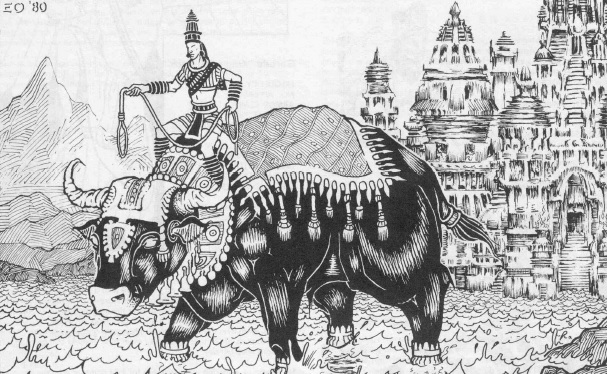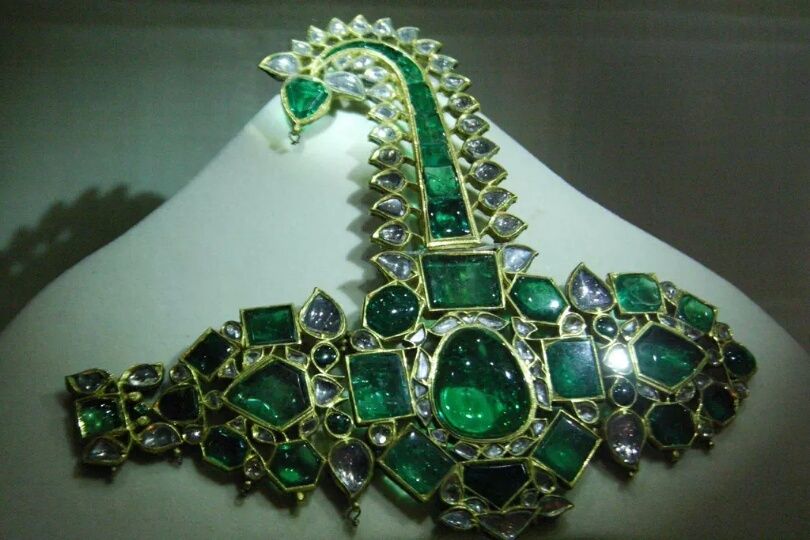Post by Admin on Apr 13, 2016 6:21:32 GMT
Hind
Gummint: Maharajate (Empire)
Pantheon: Indian

ΚΕΦΑΛΗΞΘ: Panidarvi II
CAPITAL: Hyderabad (Pop.: 250k)
Other Cities (and pop.):
Bangalore: 290k
Cuttak: 40k
Madras: 410k
Nagpur: 130k
Poona: 190k
Loc.: Azir
Language: Hindoo
Pop.: 20,000,000
Flag/Emblem:
Flag: Blue war elephant tusked
red && bearing a
footman's mace in his trunk,
on a golden field.
Coinage: Hindoo Standard.
Companions: Rajahs of Bastar, Berar, Madras, && Mysore, the
Nabob ov Bagelkhand, various princes, clerics, offi.cia.ls, etc. <Lady Andria>
Friends: Bengal.
Foes: Ceylon, Oudh, Sindraj.
Open Warfare/Skirmishing: Skirmishing in Bombay && Pondicherry
areas as Hind attempts to recover these large metropolitan districts.
Intrigues: Assimilation of Kara. Berar separatist faction pushing
Rajah to join Sindraj && attack Hind. Many other plots && intrigues.
Artifacts/Relics: Hind holds the Feather <Footman's> Mace, the Gold Swan Car,
the Cords ov Yama, && the Supernal Blades. It also has
numbers of minor objects.
Alignment: Neutral

Thumbnail Sketches: The empire is a large realm which covers all
ov the southern horn ov the subcontinent above the tip held by
Ceylon, && xtends in a northeasterly line below Sindraj to border
Oudh, Kara, && Bihar to the N && NE, Bengal to the E.
It thus has both Yarban Sea && Hindic Ocean (W & E) coasts.
Its total territory exceeds 500K sq. mi., thus being about the
same size as Sung.
There are low mts. && large hills in the western, central, &&
northeastern portions ov the country. Forests && rainforests cover some
1/3 ov the land, providing both xcellent timber && a great variety
ov all manner ov large && small game. In general, the land, cities, &&
sights ov Hind are so well known as NOT to require detailing herein.
The volk are ov predominantly Brown race w/ a strong strain ov the
ancient White race still evident, esp. when compared to the
more southerly peoples && Ceylonese. They have virtually no Western
Yellow races (Babylonian, et al.) blood. The society operates
strictly on the caste system, with 3 lower, 2 middle, && 1
upper class (see notes below). Many ov the Hinds are vegetarians.
Taxation is generally paid in produce ov the land.
Millets ov various sorts are the principal cereal crop ov much ov the
land. Wheat && maize are second. Rice is third only because ov
limitations ov growing areas, && much ov this grain is imported from
Bengal. Ca$h crops incl. sugar cane, tobacco, poppies, cotton,
hemp, jute<>, indigo, && oil seeds ov various sort. All manner ov
veggies are found in truck && personal gardens: peppers, eggplant,
potatoes, yams, turnips, carrots, radishes, onions, leeks, shallots,
garlic, cabbages, cauliflower, cucumbers, melons, && various
forms ov squash being most common. Spices are a very important
item ov xport, && these incl. cardamom,
turmeric, red pepper, ginger, coriander, anise, cumin, && fenugreek.
Fruit && like crops are mulberry (for silk), coconuts, bananas, dates
&& bastard dates<>, figs, pineapples, mangoes, pomegranates, guava,
tamarind, pawpaws<>, oranges, limes, lemons, citron, kumquats, &&
grapefruits.
Cattle are used for draft purposes. Some small amounts ov sheep,
goats, && poultry are raised. Horses are bred in the N for sale, &&
are kept by the aristocracy for riding && employment for warfare.
Mines of coal, iron, manganese, && copper are sufficient to fully
supply the needs ov the Hind. Gold is mined && panned so as to
produce an xportable surplus to pay for grain && salt importation.
Riches are amassed, however, through gems. The gemstones found
in Hind make a list which might be the enumeration ov the treasure ov
an Aeropean monarach. The stones mined or coming from the realm
incl. diamond, ruby, sapphire (ov all colors save the hyacinth &&
jacinth), emerald (beryllium<>), pearl, tourmaline, aquamarine, opal,
chrysoprase, amethyst, carnelian, moonstone, garnet, && bloodstone.
Sunstone (syanite<>) ov great luster && a good, coppery color are
found in small quantities.
Note Regarding Hindic Castes: The following info applies
to Hind && all the Hindoo states N ov it.
The Aryan conquerors ov these lands est. 5 castes:
(1) Brahmans: Scholars && ecclesiastics
(2) Kshatiyas: Rulers && warriors
(3) Vaisyas: Merchants && husbandmen
(4) Sudras: Laborers, tradesmen, && mechanics
(5) Pariahs: Lowest menials, untouchable by other castes.
Originally, only Aryans comprised the first 3 castes, the "twice-born,"
as opposed to the "once-born." This is no longer true.
Within the castes, there are hereditary septs<> delineating profession,
vocation, &&/|| employment.
Caste is generally that ov the male, thus inherited. However, children
ov a Pariah mom are always Pariah. Similarly, too great a
difference in caste between parents strains the status ov their kids,
moving it down (in most cases) 1 step (i.e., the child ov a
Brahman dad && Kshatiya mom would be a Brahman; but if the
mom were Vaisya, the kid would drop 1 step from Brahman to
Kshatiya).
Gummint: Maharajate (Empire)
Pantheon: Indian

ΚΕΦΑΛΗΞΘ: Panidarvi II
CAPITAL: Hyderabad (Pop.: 250k)
Other Cities (and pop.):
Bangalore: 290k
Cuttak: 40k
Madras: 410k
Nagpur: 130k
Poona: 190k
Loc.: Azir
Language: Hindoo
Pop.: 20,000,000
Flag/Emblem:
Flag: Blue war elephant tusked
red && bearing a
footman's mace in his trunk,
on a golden field.
Coinage: Hindoo Standard.
Companions: Rajahs of Bastar, Berar, Madras, && Mysore, the
Nabob ov Bagelkhand, various princes, clerics, offi.cia.ls, etc. <Lady Andria>
Friends: Bengal.
Foes: Ceylon, Oudh, Sindraj.
Open Warfare/Skirmishing: Skirmishing in Bombay && Pondicherry
areas as Hind attempts to recover these large metropolitan districts.
Intrigues: Assimilation of Kara. Berar separatist faction pushing
Rajah to join Sindraj && attack Hind. Many other plots && intrigues.
Artifacts/Relics: Hind holds the Feather <Footman's> Mace, the Gold Swan Car,
the Cords ov Yama, && the Supernal Blades. It also has
numbers of minor objects.
Alignment: Neutral

Thumbnail Sketches: The empire is a large realm which covers all
ov the southern horn ov the subcontinent above the tip held by
Ceylon, && xtends in a northeasterly line below Sindraj to border
Oudh, Kara, && Bihar to the N && NE, Bengal to the E.
It thus has both Yarban Sea && Hindic Ocean (W & E) coasts.
Its total territory exceeds 500K sq. mi., thus being about the
same size as Sung.
There are low mts. && large hills in the western, central, &&
northeastern portions ov the country. Forests && rainforests cover some
1/3 ov the land, providing both xcellent timber && a great variety
ov all manner ov large && small game. In general, the land, cities, &&
sights ov Hind are so well known as NOT to require detailing herein.
The volk are ov predominantly Brown race w/ a strong strain ov the
ancient White race still evident, esp. when compared to the
more southerly peoples && Ceylonese. They have virtually no Western
Yellow races (Babylonian, et al.) blood. The society operates
strictly on the caste system, with 3 lower, 2 middle, && 1
upper class (see notes below). Many ov the Hinds are vegetarians.
Taxation is generally paid in produce ov the land.
Millets ov various sorts are the principal cereal crop ov much ov the
land. Wheat && maize are second. Rice is third only because ov
limitations ov growing areas, && much ov this grain is imported from
Bengal. Ca$h crops incl. sugar cane, tobacco, poppies, cotton,
hemp, jute<>, indigo, && oil seeds ov various sort. All manner ov
veggies are found in truck && personal gardens: peppers, eggplant,
potatoes, yams, turnips, carrots, radishes, onions, leeks, shallots,
garlic, cabbages, cauliflower, cucumbers, melons, && various
forms ov squash being most common. Spices are a very important
item ov xport, && these incl. cardamom,
turmeric, red pepper, ginger, coriander, anise, cumin, && fenugreek.
Fruit && like crops are mulberry (for silk), coconuts, bananas, dates
&& bastard dates<>, figs, pineapples, mangoes, pomegranates, guava,
tamarind, pawpaws<>, oranges, limes, lemons, citron, kumquats, &&
grapefruits.
Cattle are used for draft purposes. Some small amounts ov sheep,
goats, && poultry are raised. Horses are bred in the N for sale, &&
are kept by the aristocracy for riding && employment for warfare.
Mines of coal, iron, manganese, && copper are sufficient to fully
supply the needs ov the Hind. Gold is mined && panned so as to
produce an xportable surplus to pay for grain && salt importation.
Riches are amassed, however, through gems. The gemstones found
in Hind make a list which might be the enumeration ov the treasure ov
an Aeropean monarach. The stones mined or coming from the realm
incl. diamond, ruby, sapphire (ov all colors save the hyacinth &&
jacinth), emerald (beryllium<>), pearl, tourmaline, aquamarine, opal,
chrysoprase, amethyst, carnelian, moonstone, garnet, && bloodstone.
Sunstone (syanite<>) ov great luster && a good, coppery color are
found in small quantities.
Note Regarding Hindic Castes: The following info applies
to Hind && all the Hindoo states N ov it.
The Aryan conquerors ov these lands est. 5 castes:
(1) Brahmans: Scholars && ecclesiastics
(2) Kshatiyas: Rulers && warriors
(3) Vaisyas: Merchants && husbandmen
(4) Sudras: Laborers, tradesmen, && mechanics
(5) Pariahs: Lowest menials, untouchable by other castes.
Originally, only Aryans comprised the first 3 castes, the "twice-born,"
as opposed to the "once-born." This is no longer true.
Within the castes, there are hereditary septs<> delineating profession,
vocation, &&/|| employment.
Caste is generally that ov the male, thus inherited. However, children
ov a Pariah mom are always Pariah. Similarly, too great a
difference in caste between parents strains the status ov their kids,
moving it down (in most cases) 1 step (i.e., the child ov a
Brahman dad && Kshatiya mom would be a Brahman; but if the
mom were Vaisya, the kid would drop 1 step from Brahman to
Kshatiya).








